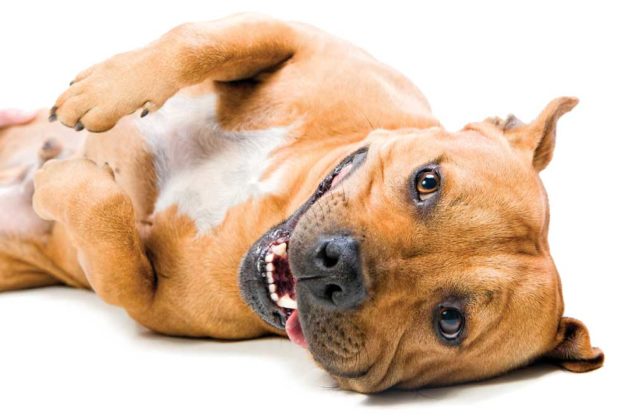Unfortunately, our dogs can’t tell us how they’re feeling. But we can get a pretty good idea by reading their body language.
When your dog barks as you enter the house, you recognize it as a joyful greeting. If he whines as you’re eating a sandwich, you know it means “can I have some?” But do you know how to read his body language?
Body language is a large part of canine communication. A dog’s stance and bearing, and the position of his ears, head and tail are all signals to the outside world about how he’s feeling. By learning how to recognize and interpret these signs, you’ll be able to better understand and bond with your dog.
Play
When a dog is playing, his ears are up and forward. His mouth is usually open and the eyes are relaxed. Play among dogs is the way they learn to fight, hunt and reproduce. Many times the first move to initiate play is a bow or pawing the air. It’s as if they are telling each other that all the biting, growling and stalking isn’t serious – it’s playtime!
As you watch dogs at play, you’ll notice that even if they’re rough, they’re fairly relaxed. Lips are down, covering their teeth, not drawn back in a snarl. There are no threatening stares. Their barks are often higher pitched and have more “fun” in them than a deeper warning or “I’m scared” bark.
Confidence
A confident dog stands erect, tail up with a slow sweeping wag. The ears are up or relaxed and he looks directly at you. His pupils are small. A confident dog is a relaxed dog. Every muscle in his body is relaxed and he has a bounce in his step. His stance won’t change even when another dog approaches or sniffs his behind.
Fear
Fear is shown by a lowered stance with the tail down or tucked under the bottom. Sometimes the tail will do a quick, frantic wag. The dog will look away and the pupils are dilated. He may bark out of fear to warn whatever is there to stay away. This barking can become intense if he’s fenced in, on a leash or cornered.
Many times, fear will arouse a dog and his hair will stand on end on his “hackles”, the area over the shoulders and just in front of the tail. This show of fear or uncertainty may not mean he’ll become aggressive, but it is a warning he is on high alert and ready to defend or attack.
Dominance
Alpha dogs have a very calm way of showing their dominance. Standing tall is one. Another is by putting his head or paw over another dog’s shoulders. He might accept a lick on the mouth or even stare at the other dog with calm eyes. A few dominant dogs will roll on their backs to expose their bellies; this reassures a shyer dog, but they will still look the other dog in the eye from this position. “Humping” can be a sign of dominance but can also be used by lowerranking dogs to try and demonstrate allegiance to the alpha dog.
Submission
The submissive dog will lower his head and allow other dogs to stand over him. He may lick another dog’s lips and mouth while looking away. He might roll on his back with his head pointed away from the other dog. His tail will probably be between his legs. There is nothing wrong with a submissive dog; as with people, there are leaders and non-leaders.
Forcing a dog into submissive behavior by forcing him on his back is the same as striking a child. Any hitting, shaking or physical aggression is asking for trouble and could provoke an attack. If there’s good communication to start with, confrontations need not happen.
Stress
Dogs can get stressed in many different situations but usually it’s through frustration or fear, as in learning something new or not being able to do something. Signs of stress are dilated pupils, rapid panting with the corners of the mouth pulled back, lowered tail, “submissive” urination, whining, shaking, scratching, sniffing, turning the head away or “fence barking or fighting”, something kenneled dogs often do as another dog walks by on a leash. Many leashed dogs are frustrated because they can’t run, while dogs in kennels are frustrated because they can’t get out.
Calmness
Because dogs are pack animals, they have developed ways of diffusing and even avoiding conflict and aggression. Calming signs include yawning, looking away, lip-licking, circling, lying down calmly and even “shaking” off tension. The shaking looks the same as if the dog were wet and trying to get the water off, but in this case he’s shaking off the tension. Many small dogs “shake” to get rid of tension or stress when they are out in public or feel out of place.
Aggression
Watch your dog’s body. A stiff, tense body and legs mean aggression when they’re coupled with a lowered head and laid-back ears, an intense stare, snarling lips and raised “hackles”. An aggressive or angry dog will also have his tail straight out behind him. Take some time to observe your dog as he goes through his daily routine. Look at his body as he plays, relaxes, responds to new situations and relates to others. By tuning in to his body language, you’ll gain a much better understanding of the canine mind and emotions, and that understanding will greatly enhance your bond
Dog to dog
When two dogs meet, the general rule of thumb is to let them decide what is and isn’t appropriate. Butt-sniffing, rough play and barking in each other’s ears may not be acceptable to humans, but are perfectly normal in the canine world.
However, if your dog’s actions are annoying, scaring or angering another dog, it’s up to you to do something about it. Take him away from the action for some light-hearted calming time.
If you find your dog has a number of aggressive encounters with other dogs, stop and observe his body language. Is he getting “in the face” of the other dog, or failing to respond to his/ her submissive or calming signals?
Remember that your dog can feel your emotions. If you’re unsure about another dog, he’ll be unsure too. Keep your feelings in check when another dog approaches. Be the alpha leader and your dog will respond better.
It’s our responsibility to make sure our dogs are safe. Studying his body language can help you pick up on what he’s feeling and saying even before he starts to bark or growl.

